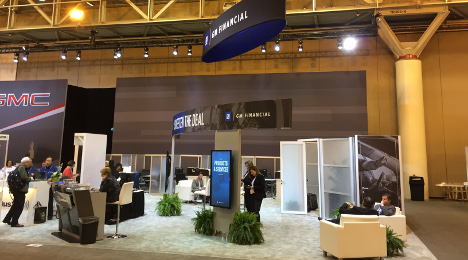GM Financial to see 1 million off-lease units in next 3 years

GM Financial's booth at the NADA Convention & Expo. The captive expects to see 1 million off-lease units in the next three years, says Nick Heinz, vice president of remarketing solutions.
There will likely be a record 3.6 million off-lease vehicles this year, according to Manheim’s 2017 Used Car Market Report.
“And that’s not even close to the peak,” Cox Automotive Inventory Solutions president Janet Barnard said during a press conference here at the NADA Convention & Expo.
That, she said, will happen in 2020, when 4.6 million cars come off lease.
“Selfishly, with Manheim as one of our large brands in our portfolio, that’s really good news for us,” Barnard said. “But honestly, if all we become is parking lots, the news isn’t so good.
“And that’s true whether you’re a dealer or whether you’re Manheim or any part of this automotive industry,” she said. “If things don’t move, if no transactions happen, no one is successful.”
That, Barnard said, will be a common theme in the company’s messaging over the next few years. Taking it a step further, keeping off-lease cars moving will likely be an integral theme in the remarketing industry at large for a while.
But it’s not like the off-lease surge has snuck up on anyone.
“This is no surprise to us,” she said. “This train’s been racing down the tracks.”
The captive view
At General Motors Financial, that train is a full load.
The captive will have 1 million vehicles coming off lease in the next three years, says Nick Heinz, who vice president of remarketing solutions for GM Financial.
In an interview here, Heinz says that a unique challenge for captive finance company consignor like GM Financial is that customer retention plays into their goals, in addition to value retention of the asset they’re remarketing.
Granted, a company having a million leases come to an end over the course of 36 months is a challenge of its own.
“But we also understand that with each one of those cars comes a customer,” Heinz said.
GM Financial, he said, currently has a customer-retention rate in the high 70-percent range.
So, if they can keep up that kind of retention with all those customers exiting leases, that’s quite an opportunity.
It’s also a lot of assets coming back.
To handle the off-lease volume and get out in front of the challenge, the primary objective for the past year, Heinz said, has been to push dealer engagement to “find a home” for those cars
He says a “pretty high” percentage of their GM dealers are buying from GM Financial through its various remarketing channels, but they do want to up that number.
One avenue GM Financial has is its online platform, GMFDealerSource.com, which Heinz said is “still relatively new.”
So, there are competitive platforms out there, where GM dealers can find off-lease volumes from other online consignors. So Heinz sees an opportunity to engage dealers further with GMF DealerSource.
GM Financial has teams in-house at corporate headquarters and in the field who are raising awareness among dealers and educating them.
Collaboration with CPO
Of course, a popular destination for many off-lease vehicles is automaker certified pre-owned programs.
When asked if GM Financial has any sort of collaborative work with the General Motors CPO program, Heinz pointed to the captive’s dealer-facing incentive program called GM Financial Dealer Dividends.
Dealers might earn dividends for originations engagement and buying grounded lease vehicles, Heinz said, which then go into their dividends bank.
Dealers can put those dividends towards a variety of different things on the new- and used-car side, he said, including reimbursement on certified pre-owned fees, for example.
“We have a very unique program on that side where we allow a dealer to redeem them for down payment assistance on a certified pre-owned or a Factory Pre-Owned Collection pre-owned vehicle, which is very unique in that we’re allowing them to apply bonus cash on a pre-owned deal,” he said.
“And so, we have some synergies there through the dividends program … as we continue to go forward, you’ll see a much tighter integration in terms of the dealer engagement and the incentive structures,” Heinz said.

 View The Latest Edition
View The Latest Edition

